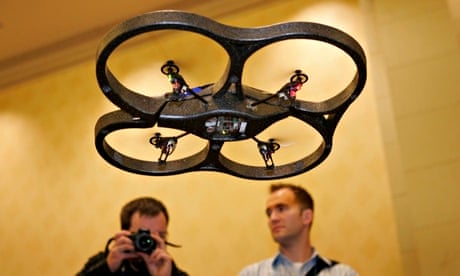Already the drone is a well-established tool for photographers wishing to capture aerial footage without the eye-watering expense of a helicopter, but artists are now finding many more imaginative uses.
There’s Cirque du Soleil’s Sparked – a live interactive performance between humans and drones – and John Cale and Liam Young’s drone-based audiovisual collaboration LOOP>>60Hz. Then there’s Disney’s patented Pixels in the Sky flying marionettes and our very own dancing quadrotor show Meet your Creator. We’re beginning to realise that, far from being Homeland-style killing machines, drones offer a whole new way to create spine-tingling performance art.
Drone culture grew from hobbyist enthusiasts. From Nixie, where drone meets wearable technology, to Drone it Yourself – a kit that turns almost anything into a quadcopter – and the DJI Inspire One, the ultimate consumer drone, the market is now thoroughly well catered for. Advancements have been so dramatic that drones recently hit the mainstream, thanks to selling in high street stores like Maplin.
The drone’s ascent has been so damned meteoric that legislation has failed to keep up, which explains why there’s so much debate about how drones will interfere with air traffic control. While Nasa works to combat the issue, drone amateurs are relatively free to do what they want, where they want.
Unfortunately, anyone who wants to use drones in a professional capacity has to jump through some complex Civil Aviation Authority hoops. A blanket ban may be lurking on the horizon, but we are – for the moment – still relatively free to explore the artistic potential of drones, especially in private indoor spaces.
Legislation aside, there’s another fly in the ointment: reliability. It’s all very well developing drone performance in a warehouse, but transport that to a live experience with an audience of 2,000 people glued to their smartphones, and lots of interference and unknowns come into play.
The good news is that these issues will be ironed out by continual improvement because, as drone maestro Raffaello D’Andrea illustrates in his TED talk on the athletic power of quadcopters, drones are becoming increasingly intelligent.
If you can handle a bit of red tape and have the constitution to deal with moments of heart-in-your-mouth unpredictably, drones are a worthy addition to any artist’s repertoire. Why? Put simply, they can create intensely immersive experiences that resonate more deeply.
FPV (first person view) is perhaps the drone’s most obvious creative application. Flying quadrotors can enter terrain that people cannot. From volcanoes to war zones, drones are giving us all sorts of new perspectives.
In addition to breaking down these geographical barriers, drones can similarly help dissolve the barrier between art and audience. By their very nature they can move into the audience’s space, leaving viewers feeling like a more integral part of the performance.
Drones also liberate performance art with a new degree of positional control. Puppets, characters, lights and cameras can now all be controlled and choreographed by drones. Although there is that aforementioned element of risk, as GPS becomes more refined with iterations such as RTK (real time kinematic: 100 times more accurate than a standard GPS receiver) positioning becomes more precise. This unleashes new possibilities in 3D spatial design.
Arguably, the most fascinating artistic extension of drones is taking FPV perspectives into connected communities and virtual reality (VR). When VR is combined with FPV, we can realise one of humanity’s longest held desires: knowing what it feels and looks like to fly over vast landscapes, a la Oculus FPV.
We’re currently working with Nesta on Project Daedalus, a trial to see how audiences engage with and share drone content in real-time. Although at an early stage, the project’s already highlighted how drones can stream anything, not just video footage.
For example, with LiDAR (a portmanteau of “light” and “radar”), an environment can be scanned rather than filmed, and the resulting data can be used to imagine far more creative outputs than mere video. Through LiDAR, drones provide a different way of sensing surroundings – a new set of eyes in the sky.
In sharp contrast to their warmongering reputation, drones are an inspiring addition to the emerging digital tools that creative communities can use to craft unique and beautiful artworks and performances. Of course, there will inevitably be those who can’t resist flirting with drones just for the sake of using the latest new tech, but if we only use drones when they offer fresh and purposeful opportunities that can’t be found elsewhere, 2015 will see us channelling a whole new way of creating show-stopping experiences and art.
Robin McNicholas is creative director at Marshmallow Laser Feast
More like this
Post-web tech: what comes next for museums?
Ten global R&D projects that are changing arts and culture
Why the arts must embrace its digital vulnerabilities
Join our community of arts, culture and creative professionals by signing up free to the Guardian Culture Pros Network.

Comments (…)
Sign in or create your Guardian account to join the discussion